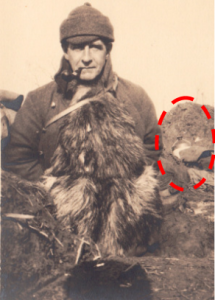Thursday, February 25, 1915
In billets, Armentières
The Battalion War Diarist wrote for this day: “Platoons in trenches relieved at night by other platoons of Battalion.” [1]

THIS DAY IN RMR HISTORY: TOMMY’S RUM – Part 1 – An English newspaper gave an account of the War Office arrangements for the supply of rum for the British soldiers:
“Now that the nights are beginning to be cold, Tommy Atkins in the trenches in France is beginning to feel the need of “something to keep out the cold.” With timely forethought for the welfare of the British soldier during a prospective winter campaign, the War Office is sending to the front a consignment of 150,000 gallons of rum. The bottling of this quantity, which in the ordinary circumstances would probably represent an excise duty of something like £60,000, is being undertaken by the Port of London Authority, and the Rum Quay at the West India Docks offers a scene of exceptional activity even for a department which is accustomed to deal with thousands of puncheons in the course of a year. The huge vats at the West India Docks, which have an aggregate capacity of 58,500 gallons, are of course available for blending of this Army rum. All of it is genuine sugar cane product, requiring no addition of spirit, since it is already much over proof. Some of it was imported in 1911, and some in succeeding years, but the age is not necessarily indicated by the date of importations. Emerging from the vats 4.5 per cent under proof, the rum is measured by the gallon and passed through funnels into stoneware jars of the customary type, and each of one gallon capacity. The jars are then corked and sealed with the seal of the Port Authority.
The next stage is the packing of the rum. For convenient handling it is placed in wooden cases, which accommodate a couple of jars. The case is kept to a size which can easily be lifted by one man, so as to give as little trouble as possible in distributing the rum among widely scattered troops. Each case bears an intimation that it forms part of the Army supplies. About 3,000 jars of the rum are sent away each day. The destination is Newhaven via Willow Walk Railway Station. From the Sussex port the consignments go to the most convenient Continental port, thereafter to be forwarded to the base of operations. Large supplies of jars, of which a total of 150,000 will of course be required, arrive daily at the West India Docks. With the active co-operation of the Customs the work of bottling proceeds until 6 p.m., instead of 4 p.m., as is usual in the case of bonded warehouses. In this way, and with the employment of a large staff of men, this big War Office order is in the process of careful execution.” [2]
[1] War Diary, 14th Canadian Battalion, The Royal Montreal Regiment, Feb 25, 1915. Library and Archives Canada, Ottawa, http://data2.collectionscanada.ca/e/e044/e001089695.jpg
[2] “Tommy`s Rum,” The Journal of Commerce, Montreal, Quebec, Saturday, October 24, 1914, pg. 4, col. 1.

